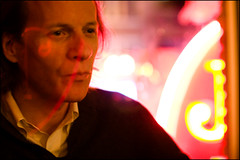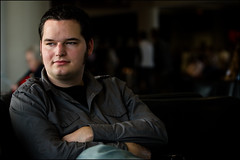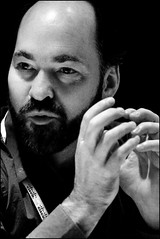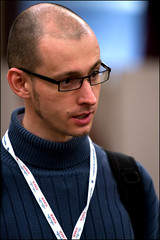Photographing Conferences
At OOPSLA 2008 I participated in a workshop on Photographing Conferences organized by Richard Gabriel and Kevin Sullivan (photo on the right).
The announcement described the workshop as follows:
Photographing a conference is not a matter of point and shoot. And it's not just about pix to share with friends and family - the time is ripe for both serious photojournalism to capture our community's leaders, its activities, and its human face and for the use of artistry to tell stories and get people thinking. In this workshop you will learn the basic technical and aesthetic techniques for good conference photography, and you will practice these techniques during OOPSLA. Work will be critiqued using a writers' workshop process to enable you to continue learning and improving after the workshop. Participants will be expected to attend a full-day of lectures and interactive learning activities as well as photograph Monday, Tuesday, and Wednesday with short, early morning writers' workshops on Tuesday, Wednesday, and Thursday.
And so we did. On the first day (Sunday) we sat in a dark room reviewing photoshop techniques. During the rest of the week we went around making photos of the event. Every morning we had photo review sessions starting at 6:30 AM!. I was thoroughly exhausted at the end of the week.
During the week I took about 800 photos. Today I finally got around to finishing the postprocessing. Only 39 made it to my flickr account, which you can see in my OOPSLA 2008 set.
A funny visual detail at OOPSLA 2008 were the white badge dispenser cords that all participants wore. On many of my shots they form clear white triangles with quite some impact on the composition. The white of the cords also turned out to be very useful for adjusting the white balance during postprocessing.
Despite my intention to practice making photos of scenes with multiple persons, my best shots, and therefore most of what I’ve published on flickr, are close-up portraits. So my photos of the conference probably do not give an impression of the event, but they should be useful in putting faces to some of the names in the community.

For me the workshop was a success. That is, it has improved my photography. The most learning I probably got from preparing for the workshop. The workshop program required participants to read the book Understanding Exposure by Bryan F. Peterson. As a long time photographer I had the illusion that I knew everything there was to know, but I decided to get the book anyway and even read it. It turned out I had a lot to learn about making good exposures, in particular, about making more conscious decisions about aperture and shutter speed depending on the story you’re trying to tell with a shot. Thus, shunning the fully automatic modes of my camera, I’ve been shooting in manual or semi-automatic (aperture priority) since the summer of 2008 with practice runs at ICMT 2008 in Zurich and MODELS/SLE 2008 in Toulouse.
Shooting in manual mode is no panacea. It can produce better results since slightly shifting the camera may make the camera decide to make a different decision on the lighting. However, it also requires continuous awareness and adjusting, which has made me miss quite a few shots as well.

The other preparation for the workshop consisted in getting (partially as a birthday present) a telelens for better candid photography. Since the summer of 2007 I had been shooting mainly with a 50mm fixed objective. This lens provided much better optics than the 17-85mm zoom lens I originally got with my EOS 30D. With its 1.8 (later I got the 1.4) aperture it can deal with poor light conditions and provides a nice background blur in portraits.
However, a 50mm lens is not ideal for conferences. Speakers and audience don’t take it too well if you are in their face. So I needed a tele-zoom lens, and one that would do well under the typically poor light conditions of conferences. After a lot of agonizing about the price, and with a little help from my friends, I finally couldn’t resist the Canon EF 70-200mm 1:2.8 L IS USM, a monstrous lens of 1.5 kg, but with maximum aperture of 2.8 over the whole range and image stabilization, which should help three stops. I got the lens just a few days before I left to Nashville, and it took some getting used to. But I can’t do without anymore.

Most importantly, the workshop legitimizes taking photos at conferences, which I had been doing already a bit before, but never quite seriously. With the OOPSLA experience I’ve overcome most of my hesitations. So I’ll definitely take my camera again to future events.



